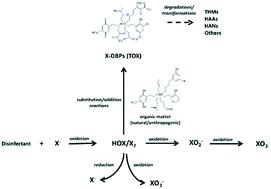当前位置:
X-MOL 学术
›
Environ. Sci.: Water Res. Technol.
›
论文详情
Our official English website, www.x-mol.net, welcomes your feedback! (Note: you will need to create a separate account there.)
The forest or the trees: a critical review on the analysis of total organic halogen (TOX) in drinking waters and its utility as a water quality parameter
Environmental Science: Water Research & Technology ( IF 5 ) Pub Date : 2020-07-06 , DOI: 10.1039/d0ew00300j Ina Kristiana 1, 2, 3, 4, 5 , Suzanne McDonald 1, 2, 3, 4, 5 , Cynthia A. Joll 1, 2, 3, 4, 5
Environmental Science: Water Research & Technology ( IF 5 ) Pub Date : 2020-07-06 , DOI: 10.1039/d0ew00300j Ina Kristiana 1, 2, 3, 4, 5 , Suzanne McDonald 1, 2, 3, 4, 5 , Cynthia A. Joll 1, 2, 3, 4, 5
Affiliation

|
The formation of disinfection by-products (DBPs) is challenging from both public health and drinking water treatment perspectives. Over 700 DBPs have been identified, however, a large proportion of halogenated DBPs are unknown, and the compounds responsible for the observed associations between consumption of disinfected drinking water and adverse health outcomes have yet to be identified. The measurement of total organic halogen (TOX) provides the only measure of the overall formation of halogenated DBPs, and is an attractive alternative to the measurement of individual DBPs. This paper presents a critical review of the analysis of TOX and the utility of TOX as a water quality parameter in drinking water treatment. In TOX analysis, the evolution of instrument technology has improved the sensitivity and selectivity of the measurement, and the use of good quality activated carbon was found to be crucial to achieving good recoveries (>90%). The concentrations of TOX in drinking water are not static, with the transformation or degradation of TOX over time forming smaller DBPs. Advanced oxidation processes (AOPs) could reduce or promote the formation of TOX as a result of transformations of precursor materials. Evaluation of the available existing data showed strong correlations between molar concentrations of TOX, and THMs and HAAs. Positive correlations between the concentrations of TOX and the in vitro toxicity of disinfected waters have also been reported. Therefore, one measurement of TOX can potentially provide information on the levels of regulated DBPs and toxicity in a sample, which means that a comprehensive assessment of water quality can potentially be achieved with a single measurement of TOX.
中文翻译:

森林:对饮用水中总有机卤素(TOX)的分析及其作为水质参数的实用性的批判性评论
从公共卫生和饮用水处理的角度来看,消毒副产物(DBPs)的形成都具有挑战性。已鉴定出700多种DBP,但是,未知的卤代DBP占很大比例,而且尚未发现造成消毒饮用水消耗与不良健康结果之间相关性的化合物。总有机卤素(TOX)的测量提供了卤代DBP整体形成的唯一测量,并且是单个DBP的一种有吸引力的替代选择。本文对TOX的分析以及TOX作为饮用水处理中水质参数的实用性进行了严格的评述。在TOX分析中,仪器技术的发展提高了测量的灵敏度和选择性,并且发现使用高质量的活性炭对于实现良好的回收率(> 90%)至关重要。饮用水中TOX的浓度不是一成不变的,随着时间的推移,TOX的转化或降解会形成较小的DBP。先进的氧化过程(AOP)可能会减少或促进前驱物材料转变导致TOX的形成。对现有数据的评估表明,TOX,THM和HAA的摩尔浓度之间存在很强的相关性。TOX浓度与血药浓度之间呈正相关 先进的氧化过程(AOP)可能会减少或促进前驱物材料转变导致TOX的形成。对现有数据的评估表明,TOX,THM和HAA的摩尔浓度之间存在很强的相关性。TOX浓度与血药浓度之间呈正相关 先进的氧化工艺(AOP)可能会减少或促进前驱物材料转变导致TOX的形成。对现有数据的评估表明,TOX,THM和HAA的摩尔浓度之间存在很强的相关性。TOX浓度与血药浓度之间呈正相关还已经报道了消毒水的体外毒性。因此,一次TOX测量可以潜在地提供有关样品中调节DBPs水平和毒性的信息,这意味着通过一次TOX测量就可以潜在地实现对水质的全面评估。
更新日期:2020-08-27
中文翻译:

森林:对饮用水中总有机卤素(TOX)的分析及其作为水质参数的实用性的批判性评论
从公共卫生和饮用水处理的角度来看,消毒副产物(DBPs)的形成都具有挑战性。已鉴定出700多种DBP,但是,未知的卤代DBP占很大比例,而且尚未发现造成消毒饮用水消耗与不良健康结果之间相关性的化合物。总有机卤素(TOX)的测量提供了卤代DBP整体形成的唯一测量,并且是单个DBP的一种有吸引力的替代选择。本文对TOX的分析以及TOX作为饮用水处理中水质参数的实用性进行了严格的评述。在TOX分析中,仪器技术的发展提高了测量的灵敏度和选择性,并且发现使用高质量的活性炭对于实现良好的回收率(> 90%)至关重要。饮用水中TOX的浓度不是一成不变的,随着时间的推移,TOX的转化或降解会形成较小的DBP。先进的氧化过程(AOP)可能会减少或促进前驱物材料转变导致TOX的形成。对现有数据的评估表明,TOX,THM和HAA的摩尔浓度之间存在很强的相关性。TOX浓度与血药浓度之间呈正相关 先进的氧化过程(AOP)可能会减少或促进前驱物材料转变导致TOX的形成。对现有数据的评估表明,TOX,THM和HAA的摩尔浓度之间存在很强的相关性。TOX浓度与血药浓度之间呈正相关 先进的氧化工艺(AOP)可能会减少或促进前驱物材料转变导致TOX的形成。对现有数据的评估表明,TOX,THM和HAA的摩尔浓度之间存在很强的相关性。TOX浓度与血药浓度之间呈正相关还已经报道了消毒水的体外毒性。因此,一次TOX测量可以潜在地提供有关样品中调节DBPs水平和毒性的信息,这意味着通过一次TOX测量就可以潜在地实现对水质的全面评估。


























 京公网安备 11010802027423号
京公网安备 11010802027423号